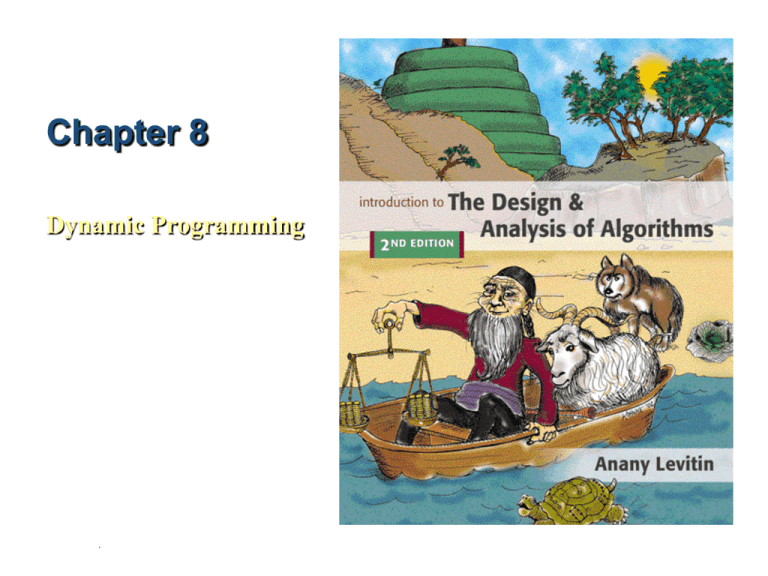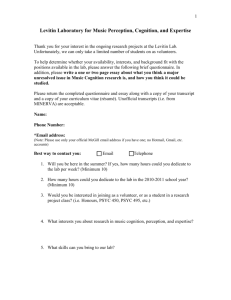
Chapter 8
Dynamic Programming
.
Dynamic Programming
Dynamic Programming:
is a general algorithm design technique for solving
problems defined by Break problems into sub problems and
combine their solutions into solutions to larger problems.
Copyright © 2007 Pearson Addison-Wesley. All rights reserved.
A. Levitin “Introduction to the Design & Analysis of Algorithms,” 2nd ed., Ch. 8
8-1
Example: Fibonacci numbers
• Recall definition of Fibonacci numbers:
F(n) = F(n-1) + F(n-2)
F(0) = 0
F(1) = 1
• Computing the nth Fibonacci number recursively (top-down):
F(n)
F(n-1)
F(n-2)
+
+
F(n-3)
...
Copyright © 2007 Pearson Addison-Wesley. All rights reserved.
F(n-2)
F(n-3)
+
F(n-4)
A. Levitin “Introduction to the Design & Analysis of Algorithms,” 2nd ed., Ch. 8
8-2
Example: Fibonacci numbers (cont.)
Computing the nth Fibonacci number using bottom-up iteration and
recording results:
F(0) = 0
F(1) = 1
F(2) = 1+0 = 1
…
F(n-2) =
F(n-1) =
F(n) = F(n-1) + F(n-2)
0
Efficiency:
- time
- space
1
1
n
n
Copyright © 2007 Pearson Addison-Wesley. All rights reserved.
. . .
F(n-2) F(n-1) F(n)
What if we solve
it recursively?
A. Levitin “Introduction to the Design & Analysis of Algorithms,” 2nd ed., Ch. 8
8-3
Examples of DP algorithms
• Computing a binomial coefficient
• Longest common subsequence
• Coin-row problem
• Floyd’s algorithm for all-pairs shortest paths
• Some instances of difficult discrete optimization problems:
- knapsack
Copyright © 2007 Pearson Addison-Wesley. All rights reserved.
A. Levitin “Introduction to the Design & Analysis of Algorithms,” 2nd ed., Ch. 8
8-4
Coin-row problem
There is a row of n coins whose values are some positive
integers c₁, c₂,...,cn, not necessarily distinct. The goal is to
pick up the maximum amount of money subject to the
constraint that no two coins adjacent in the initial row can be
picked up.
E.g.: 5, 1, 2, 10, 6, 2,
the best selection is 5, 10, 2, giving the maximum amount of
17.
5
Copyright © 2007 Pearson Addison-Wesley. All rights reserved.
A. Levitin “Introduction to the Design & Analysis of Algorithms,” 2nd ed., Ch. 8
8-5
DP solution to the coin-row problem
Let F(n) be the maximum amount that can be picked up from
the row of n coins. To derive a recurrence for F(n)
we have the following recurrence
F(n) = max{cn + F(n-2), F(n-1)} for n > 1,
F(0) = 0, F(1)=c₁
6
Copyright © 2007 Pearson Addison-Wesley. All rights reserved.
A. Levitin “Introduction to the Design & Analysis of Algorithms,” 2nd ed., Ch. 8
8-6
DP solution to the coin-row problem (cont.)
F(n) = max{cn + F(n-2), F(n-1)} for n > 1,
F(0) = 0, F(1)=c₁
index
coins
0
1
2
3
4
5
6
--
5
1
2
10
6
2
F( )
Max amount:
Coins of optimal solution:
Time efficiency:
Copyright © 2007 Pearson Addison-Wesley. All rights reserved.
A. Levitin “Introduction to the Design & Analysis of Algorithms,” 2nd ed., Ch. 8
7
8-7
Knapsack Problem by DP
Given n items of
integer weights: w1 w2 … wn
values:
v1 v2 … vn
a knapsack of integer capacity W
find most valuable subset of the items that fit into the
knapsack
Consider instance defined by first i items and capacity j (j
W).
Let V[i,j] be optimal value of such an instance. Then
max {V[i-1,j], vi + V[i-1,j- wi]} if j- wi 0
V[i,j] =
V[i-1,j]
if j- wi < 0
Initial conditions: V[0,j] = 0 and V[i,0] = 0
{
Copyright © 2007 Pearson Addison-Wesley. All rights reserved.
A. Levitin “Introduction to the Design & Analysis of Algorithms,” 2nd ed., Ch. 8
8-8
Knapsack Problem by DP (example)
Example: Knapsack of capacity W = 5
item weight value
1
2
$12
2
1
$10
3
3
$20
4
2
$15
Copyright © 2007 Pearson Addison-Wesley. All rights reserved.
A. Levitin “Introduction to the Design & Analysis of Algorithms,” 2nd ed., Ch. 8
8-9
Knapsack Problem by DP (example)
Copyright © 2007 Pearson Addison-Wesley. All rights reserved.
A. Levitin “Introduction to the Design & Analysis of Algorithms,” 2nd ed., Ch. 8
8-10
Knapsack Problem by DP (example)
Copyright © 2007 Pearson Addison-Wesley. All rights reserved.
A. Levitin “Introduction to the Design & Analysis of Algorithms,” 2nd ed., Ch. 8
8-11
Knapsack Problem by DP (pseudocode)
Algorithm DPKnapsack(w[1..n], v[1..n], W)
var V[0..n,0..W], P[1..n,1..W]: int
for j := 0 to W do
V[0,j] := 0
for i := 0 to n do
Running time and space:
O(nW).
V[i,0] := 0
for i := 1 to n do
for j := 1 to W do
if w[i] j and v[i] + V[i-1,j-w[i]] > V[i-1,j] then
V[i,j] := v[i] + V[i-1,j-w[i]]; P[i,j] := j-w[i]
else
V[i,j] := V[i-1,j]; P[i,j] := j
return V[n,W] and the optimal subset by backtracing
Copyright © 2007 Pearson Addison-Wesley. All rights reserved.
A. Levitin “Introduction to the Design & Analysis of Algorithms,” 2nd ed., Ch. 8
8-12
homework
Copyright © 2007 Pearson Addison-Wesley. All rights reserved.
A. Levitin “Introduction to the Design & Analysis of Algorithms,” 2nd ed., Ch. 8
8-13
Floyd’s Algorithm: All pairs shortest paths
Problem: In a weighted (di)graph, find shortest paths between
every pair of vertices
Same idea: construct solution through series of matrices D(0), …,
D (n) using increasing subsets of the vertices allowed
as intermediate
Example:
4
3
1
1
6
1
5
2
Copyright © 2007 Pearson Addison-Wesley. All rights reserved.
3
4
0
1
∞
6
∞
0
∞
5
4
4
0
1
∞
3
∞
0
A. Levitin “Introduction to the Design & Analysis of Algorithms,” 2nd ed., Ch. 8
8-14
Floyd’s Algorithm (matrix generation)
On the k-th iteration, the algorithm determines shortest paths
between every pair of vertices i, j that use only vertices among
1,…,k as intermediate
D(k)[i,j] = min {D(k-1)[i,j], D(k-1)[i,k] + D(k-1)[k,j]}
D(k-1)[i,k]
k
i
D(k-1)[k,j]
D(k-1)[i,j]
j
Copyright © 2007 Pearson Addison-Wesley. All rights reserved.
Initial condition?
A. Levitin “Introduction to the Design & Analysis of Algorithms,” 2nd ed., Ch. 8
8-15
Floyd’s Algorithm (example)
1
2
3 6
3
D(2) =
2
7
D(0)
=
4
1
0
2
9
6
∞
0
7
∞
3
5
0
9
∞
∞
1
0
Copyright © 2007 Pearson Addison-Wesley. All rights reserved.
0
2
∞
6
∞
0
7
∞
3
∞
0
∞
D(3) =
∞
∞
1
0
0
2
9
6
10
0
7
16
D(1)
3
5
0
9
4
6
1
0
=
0
2
∞
6
∞
0
7
∞
D(4)
3
5
0
9
=
0
2
7
6
A. Levitin “Introduction to the Design & Analysis of Algorithms,” 2nd ed., Ch. 8
∞
∞
1
0
10
0
7
16
3
5
0
9
4
6
1
0
8-16
Floyd’s Algorithm (pseudocode and analysis)
If D[i,k] + D[k,j] < D[i,j] then P[i,j] k
Time efficiency: Θ(n3)
Copyright © 2007 Pearson Addison-Wesley. All rights reserved.
A. Levitin “Introduction to the Design & Analysis of Algorithms,” 2nd ed., Ch. 8
8-17











